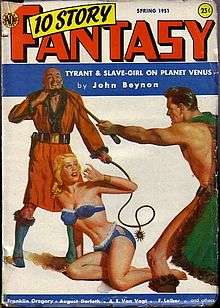The Sentinel (short story)
| "The Sentinel" | |
|---|---|
 | |
| Author | Arthur C. Clarke |
| Country | United Kingdom |
| Language | English |
| Genre(s) | Science fiction |
| Published in | Ten Story Fantasy |
| Publisher | Avon Periodicals |
| Publication date | 1951 |
"The Sentinel" is a short story written by Arthur C. Clarke in 1948, first published in 1951 as "Sentinel of Eternity", which was used as a starting point for the novel and movie 2001: A Space Odyssey, where it was modified and fused with other ideas. Clarke expressed impatience with its common description as the story that the novel and movie are based on. He explained: "I am continually annoyed by careless references to 'The Sentinel' as 'the story on which 2001 is based'; it bears about as much relation to the movie as an acorn to the resultant full-grown oak. (Considerably less, in fact, because ideas from several other stories were also incorporated.) Even the elements that Stanley Kubrick and I did actually use were considerably modified. Thus the 'glittering, roughly pyramidal structure... set in the rock like a gigantic, many-faceted jewel' became—after several modifications—the famous black monolith. And the locale was moved from the Mare Crisium to the most spectacular of all lunar craters, Tycho—easily visible to the naked eye from Earth at Full Moon."[1]
Publication history
"The Sentinel" was written in 1948 for a BBC competition (in which it failed to place) and was first published in the magazine Ten Story Fantasy in 1951, under the title "Sentinel of Eternity". It was subsequently published as part of the short story collections Expedition to Earth (1953), The Nine Billion Names of God (1967), and The Lost Worlds of 2001 (1972). Despite the story's initial failure, it changed the course of Clarke's career.
Anthology
The Sentinel (published 1982) is also the title of a collection of Arthur C. Clarke short stories, which includes the eponymous "The Sentinel", "Guardian Angel" (the inspiration for his Childhood's End), "The Songs of Distant Earth", and "Breaking Strain".
Story
The story deals with the discovery of an artifact on Earth's Moon left behind eons ago by ancient aliens. The object is made of a polished mineral, is tetrahedral in shape, and is surrounded by a spherical forcefield. The narrator speculates at one point that the mysterious aliens who left this structure on the Moon may have used mechanisms belonging "to a technology that lies beyond our horizons, perhaps to the technology of para-physical forces."
The narrator speculates that for millions of years (evidenced by dust buildup around its forcefield) the artifact has been transmitting signals into deep space, but it ceases to transmit when, sometime later, it is destroyed "with the savage might of atomic power". The narrator hypothesizes that this "sentinel" was left on the moon as a "warning beacon" for possible intelligent and spacefaring species that might develop on Earth.
In 2001: A Space Odyssey, the operation of the sentinel is activated when sunlight touches it for the first time after it was dug up.
Film
The story was adapted and expanded upon in the 1968 film, 2001: A Space Odyssey, made by famous filmmaker Stanley Kubrick.
References
External links
- "The Sentinel" title listing at the Internet Speculative Fiction Database